红酒品鉴英文版
- 格式:ppt
- 大小:5.30 MB
- 文档页数:23
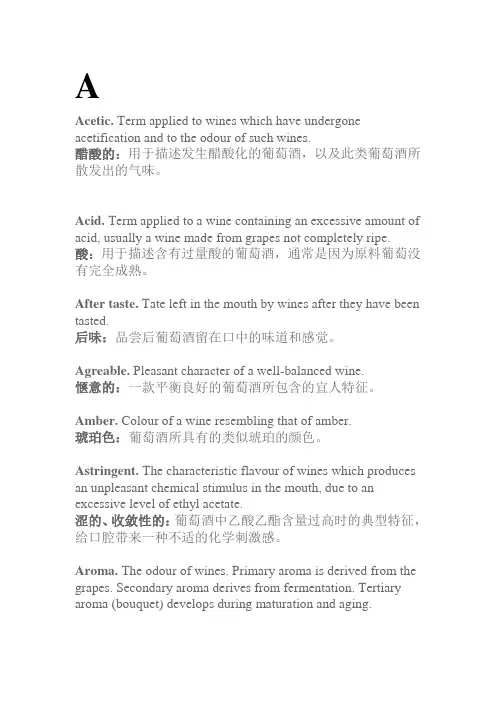
AAcetic. Term applied to wines which have undergone acetification and to the odour of such wines.醋酸的:用于描述发生醋酸化的葡萄酒,以及此类葡萄酒所散发出的气味。
Acid. Term applied to a wine containing an excessive amount of acid, usually a wine made from grapes not completely ripe.酸:用于描述含有过量酸的葡萄酒,通常是因为原料葡萄没有完全成熟。
After taste. Tate left in the mouth by wines after they have been tasted.后味:品尝后葡萄酒留在口中的味道和感觉。
Agreable. Pleasant character of a well-balanced wine.惬意的:一款平衡良好的葡萄酒所包含的宜人特征。
Amber. Colour of a wine resembling that of amber.琥珀色:葡萄酒所具有的类似琥珀的颜色。
Astringent. The characteristic flavour of wines which produces an unpleasant chemical stimulus in the mouth, due to an excessive level of ethyl acetate.涩的、收敛性的:葡萄酒中乙酸乙酯含量过高时的典型特征,给口腔带来一种不适的化学刺激感。
Aroma. The odour of wines. Primary aroma is derived from the grapes. Secondary aroma derives from fermentation. Tertiary aroma (bouquet) develops during maturation and aging.香气、果香:葡萄酒的气味。
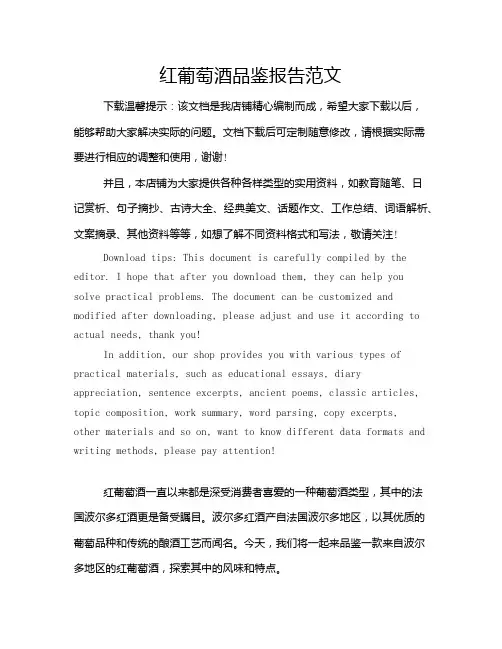
红葡萄酒品鉴报告范文下载温馨提示:该文档是我店铺精心编制而成,希望大家下载以后,能够帮助大家解决实际的问题。
文档下载后可定制随意修改,请根据实际需要进行相应的调整和使用,谢谢!并且,本店铺为大家提供各种各样类型的实用资料,如教育随笔、日记赏析、句子摘抄、古诗大全、经典美文、话题作文、工作总结、词语解析、文案摘录、其他资料等等,如想了解不同资料格式和写法,敬请关注!Download tips: This document is carefully compiled by the editor. I hope that after you download them, they can help yousolve practical problems. The document can be customized and modified after downloading, please adjust and use it according to actual needs, thank you!In addition, our shop provides you with various types of practical materials, such as educational essays, diary appreciation, sentence excerpts, ancient poems, classic articles, topic composition, work summary, word parsing, copy excerpts,other materials and so on, want to know different data formats and writing methods, please pay attention!红葡萄酒一直以来都是深受消费者喜爱的一种葡萄酒类型,其中的法国波尔多红酒更是备受瞩目。
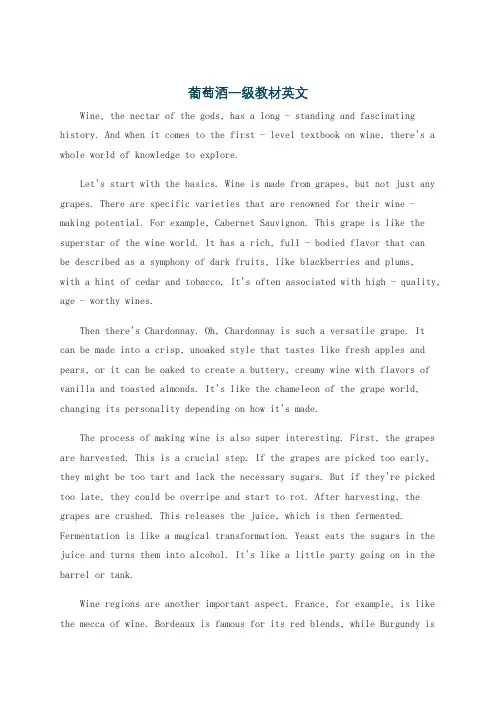
葡萄酒一级教材英文Wine, the nectar of the gods, has a long - standing and fascinating history. And when it comes to the first - level textbook on wine, there's a whole world of knowledge to explore.Let's start with the basics. Wine is made from grapes, but not just any grapes. There are specific varieties that are renowned for their wine - making potential. For example, Cabernet Sauvignon. This grape is like the superstar of the wine world. It has a rich, full - bodied flavor that canbe described as a symphony of dark fruits, like blackberries and plums,with a hint of cedar and tobacco. It's often associated with high - quality, age - worthy wines.Then there's Chardonnay. Oh, Chardonnay is such a versatile grape. It can be made into a crisp, unoaked style that tastes like fresh apples and pears, or it can be oaked to create a buttery, creamy wine with flavors of vanilla and toasted almonds. It's like the chameleon of the grape world, changing its personality depending on how it's made.The process of making wine is also super interesting. First, the grapes are harvested. This is a crucial step. If the grapes are picked too early, they might be too tart and lack the necessary sugars. But if they're picked too late, they could be overripe and start to rot. After harvesting, the grapes are crushed. This releases the juice, which is then fermented. Fermentation is like a magical transformation. Yeast eats the sugars in the juice and turns them into alcohol. It's like a little party going on in the barrel or tank.Wine regions are another important aspect. France, for example, is like the mecca of wine. Bordeaux is famous for its red blends, while Burgundy isrenowned for its Pinot Noir and Chardonnay. In Italy, Tuscany has its Chianti, a wine that's as much a part of Italian culture as pizza and pasta. These regions have their own unique climates, soils, and winemakingtraditions that contribute to the distinctiveness of their wines.Tasting wine is an art form in itself. When you first look at a glassof wine, you can observe its color. Is it a deep ruby red, a pale straw, or a golden hue? The color can give you clues about the age and type of wine. Then you swirl the wine in the glass. This releases the aromas. Sniffingthe wine is like taking a journey through a garden of scents. You might smell fruits, flowers, spices, or even earthy notes. And finally, when you take a sip, you let the wine roll around your tongue. You can taste the sweetness, acidity, tannins (in red wines), and the overall flavor profile.Wine also has a social aspect. It's often shared among friends andfamily during special occasions or just a casual get - together. There's something so warm and inviting about sharing a bottle of wine and chatting about life. It can be a great ice - breaker or a way to deepen relationships.In terms of storage, wine needs some special care. It likes to bestored in a cool, dark place, preferably on its side. This keeps the cork moist and prevents air from getting into the bottle too quickly. If youstore your wine properly, it can age gracefully and develop even more complex flavors over time.There are also different levels of sweetness in wine. There are dry wines, which have very little residual sugar, and then there are sweetwines like Port or Sauternes. Sweet wines can be a real treat, especially when paired with the right desserts. For example, a Sauternes pairs beautifully with a creamy cheesecake or a rich foie gras.Wine is not just a drink. It's a passion, a culture, and a journey of discovery. Whether you're a novice just starting to explore the world of wine or an experienced connoisseur, there's always more to learn and enjoy.。
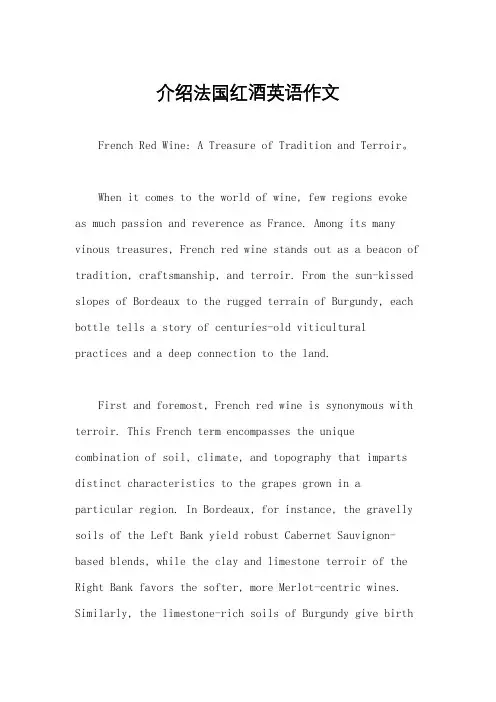
介绍法国红酒英语作文French Red Wine: A Treasure of Tradition and Terroir。
When it comes to the world of wine, few regions evoke as much passion and reverence as France. Among its many vinous treasures, French red wine stands out as a beacon of tradition, craftsmanship, and terroir. From the sun-kissed slopes of Bordeaux to the rugged terrain of Burgundy, each bottle tells a story of centuries-old viticultural practices and a deep connection to the land.First and foremost, French red wine is synonymous with terroir. This French term encompasses the unique combination of soil, climate, and topography that imparts distinct characteristics to the grapes grown in aparticular region. In Bordeaux, for instance, the gravelly soils of the Left Bank yield robust Cabernet Sauvignon-based blends, while the clay and limestone terroir of the Right Bank favors the softer, more Merlot-centric wines. Similarly, the limestone-rich soils of Burgundy give birthto elegant Pinot Noir wines renowned for their finesse and complexity.Beyond terroir, French red wine owes much of its allure to centuries of winemaking tradition. In regions like Bordeaux and Burgundy, winemaking techniques have been passed down from generation to generation, with each winemaker adding their own unique touch to the process. From hand-harvesting grapes to aging wines in oak barrels, these time-honored practices contribute to the depth and complexity found in every bottle of French red wine.Moreover, French red wine is steeped in cultural significance. In France, wine is not simply a beverage but an integral part of daily life, woven into the fabric of society and customs. Whether enjoyed with a simple meal or as part of a lavish celebration, wine brings people together, fostering conviviality and camaraderie. From the humblest bistro to the grandest chateau, the ritual of sharing a bottle of French red wine transcends social boundaries and fosters a sense of community.In addition to its cultural importance, French red wine holds a prominent place on the world stage. Renowned for their quality and consistency, wines from regions like Bordeaux, Burgundy, and the Rhône Valley command respect and admiration from wine enthusiasts and critics alike. Whether seeking a bold and robust red or a delicate and nuanced expression, there is a French wine to suit every palate and occasion.In conclusion, French red wine stands as a testament to the intersection of tradition, terroir, and craftsmanship. From the vineyards of Bordeaux to the cellars of Burgundy, each bottle reflects the rich tapestry of French winemaking heritage. With its unparalleled depth of flavor, cultural significance, and global reputation, French red wine remains a timeless symbol of excellence in the world of wine.。
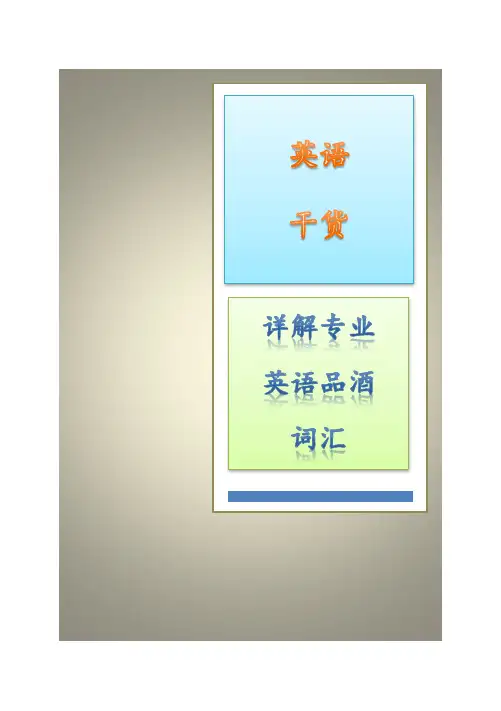
英语干货| 详解专业英语品酒词汇对于一款葡萄酒客观公正的评价应该要建立在超越个人喜好的基础之上。
打个比方,也许你不喜欢过酸的或是带有橡木味道的葡萄酒,但也许其他的消费者会喜欢这种风格,所以你应该尽可能客观地去描述它们。
今天小编通过几个典型的例子,通过中英文双语的形式来告诉大家什么是酒评,以及如何读懂它们,了解不同的品酒词汇的拿捏尺度和含义。
强烈建议收藏,在品酒时多拿出来对比一下,并且尝试自己开始写一些品酒笔记。
一、干白葡萄酒1998年路易拉图酒庄干白葡萄酒(Louis Latour, Meursault)的酒评如下:这款酒呈现出澄清透明的中等黄色,带有一丝绿色色调。
其色泽饱满鲜艳,散发着新橡木、成熟甜瓜、轻微异域水果的香气,完美而精细地表现出葡萄品种和当地风土的特点。
口感精细,带有花朵、金银花的风味,隐隐透着榛子的气息,具有黄油的丰富质感,兼具柠檬的清新酸度,整体表现非常优雅,年轻且充满活力。
酒中各物质的平衡度极佳,兼具橡木和水果的风味,余味持久,适合长期陈酿。
Clean, limpid medium yellow with a hint of green, quite rich, a really lovely colour. Touch of new wood on the nose, ripe melony fruit, slightly exotic, stylish and very expressive. Fine, floral, honeysuckle fruit on the palate, with hazelnut overtones, rich and quite buttery, yet good lemony acidity, very elegant but still young. Very good balance, oak and fruit well blended in, an excellent example of grape variety dominated by terroir, great persistence, very good future。
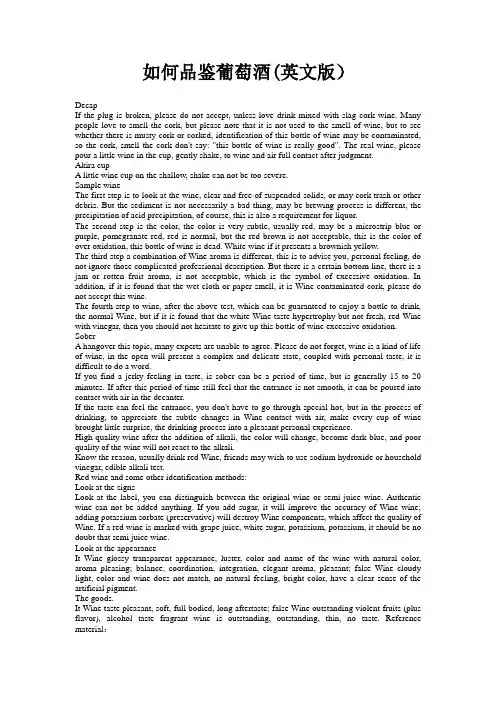
如何品鉴葡萄酒(英文版)DecapIf the plug is broken, please do not accept, unless love drink mixed with slag cork wine. Many people love to smell the cork, but please note that it is not used to the smell of wine, but to see whether there is musty cork or corked, identification of this bottle of wine may be contaminated, so the cork, smell the cork don't say: "this bottle of wine is really good". The real wine, please pour a little wine in the cup, gently shake, to wine and air full contact after judgment.Akira cupA little wine cup on the shallow, shake can not be too severe.Sample wineThe first step is to look at the wine, clear and free of suspended solids, or may cork trash or other debris. But the sediment is not necessarily a bad thing, may be brewing process is different, the precipitation of acid precipitation, of course, this is also a requirement for liquor.The second step is the color, the color is very subtle, usually red, may be a microstrip blue or purple, pomegranate red, red is normal, but the red brown is not acceptable, this is the color of over oxidation, this bottle of wine is dead. White wine if it presents a brownish yellow.The third step a combination of Wine aroma is different, this is to advise you, personal feeling, do not ignore those complicated professional description. But there is a certain bottom line, there is a jam or rotten fruit aroma, is not acceptable, which is the symbol of excessive oxidation. In addition, if it is found that the wet cloth or paper smell, it is Wine contaminated cork, please do not accept this wine.The fourth step to wine, after the above test, which can be guaranteed to enjoy a bottle to drink, the normal Wine, but if it is found that the white Wine taste hypertrophy but not fresh, red Wine with vinegar, then you should not hesitate to give up this bottle of wine excessive oxidation. SoberA hangover this topic, many experts are unable to agree. Please do not forget, wine is a kind of life of wine, in the open will present a complex and delicate state, coupled with personal taste, it is difficult to do a word.If you find a jerky feeling in taste, is sober can be a period of time, but is generally 15 to 20 minutes. If after this period of time still feel that the entrance is not smooth, it can be poured into contact with air in the decanter.If the taste can feel the entrance, you don't have to go through special hot, but in the process of drinking, to appreciate the subtle changes in Wine contact with air, make every cup of wine brought little surprise, the drinking process into a pleasant personal experience.High quality wine after the addition of alkali, the color will change, become dark blue, and poor quality of the wine will not react to the alkali.Know the reason, usually drink red Wine, friends may wish to use sodium hydroxide or household vinegar, edible alkali test.Red wine and some other identification methods:Look at the signsLook at the label, you can distinguish between the original wine or semi juice wine. Authentic wine can not be added anything. If you add sugar, it will improve the accuracy of Wine wine; adding potassium sorbate (preservative) will destroy Wine components, which affect the quality of Wine. If a red wine is marked with grape juice, white sugar, potassium, potassium, it should be no doubt that semi juice wine.Look at the appearanceIt Wine glossy transparent appearance, luster, color and name of the wine with natural color, aroma pleasing; balance, coordination, integration, elegant aroma, pleasant; false Wine cloudy light, color and wine does not match, no natural feeling, bright color, have a clear sense of the artificial pigment.The goods.It Wine taste pleasant, soft, full bodied, long aftertaste; false Wine outstanding violent fruits (plus flavor), alcohol taste fragrant wine is outstanding, outstanding, thin, no taste. Reference material:Drinking wine can be divided into 5 basic steps: view color, shake, smell wine, taste and aftertaste. As long as there is a keen feeling and spirit, pay the corresponding time and patience, you can enjoy one of the mysterious and leisurely.A WatchWine tasting red eyes began to start, because the appearance of red Wine is an important indicator of the health, the quality characteristics and the degree of the Tibetan wine.We should examine the bottle packaging, the international bar code label on the back of the bottle it starts with 3 words of French international code 3, look at the back of the bottle label is Chinese mark; open the bottle, see wood wine stopper on the text is the same, and the wine label in France, wine bottles and corks are special the. Drink red wine, the wine label is equivalent to the identity of the wine. The wine label, usually includes the name of the name of the wine, the name of the wine, wine varieties, wine capacity, alcohol, produced country, the year of the growth, where the package into the bottle and other information. For senior customers, these data is very important, such as the grape growing years, know that the growth process is perfect, but also is the immediate consumption or need to store a few years drinking better.There are distinctive patterns on the wine label. In the past, this is the sign of the winery, even handed down by the royal nobles logo, logo or Chateau scenery and buildings, are unique charm.。
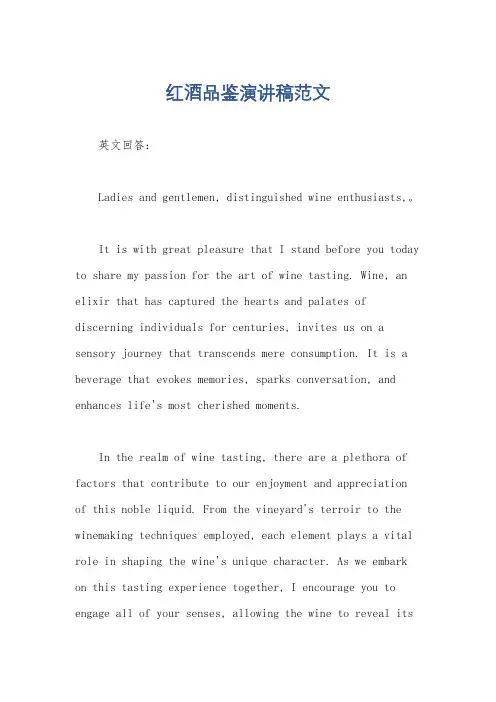
红酒品鉴演讲稿范文英文回答:Ladies and gentlemen, distinguished wine enthusiasts,。
It is with great pleasure that I stand before you today to share my passion for the art of wine tasting. Wine, an elixir that has captured the hearts and palates of discerning individuals for centuries, invites us on a sensory journey that transcends mere consumption. It is a beverage that evokes memories, sparks conversation, and enhances life's most cherished moments.In the realm of wine tasting, there are a plethora of factors that contribute to our enjoyment and appreciation of this noble liquid. From the vineyard's terroir to the winemaking techniques employed, each element plays a vital role in shaping the wine's unique character. As we embark on this tasting experience together, I encourage you to engage all of your senses, allowing the wine to reveal itsintricate layers of flavor and aroma.As we swirl the wine in our glasses, let us observe its color. The intensity and hue can provide clues about the grape variety, the winemaking process, and even its age. Next, we bring the glass to our noses and inhale deeply, seeking out the wine's bouquet. Aromatic compounds, released as the wine interacts with air, tantalize our olfactory senses, hinting at the flavors that await on the palate.With anticipation, we take our first sip, allowing the wine to bathe our tongues and activate our taste buds. The interplay of sweetness, acidity, bitterness, and tannins creates a symphony of sensations, each note contributing to the wine's overall harmony. As we savor the wine, pay attention to its weight and texture, noticing how it feels in your mouth. Is it light and refreshing, or full-bodied and opulent?Beyond the sensory experience, wine tasting also offers a glimpse into the culture and history of the region whereit was produced. Each wine tells a story, reflecting the terroir and the winemaker's artistry. As we taste and discuss these wines, let us appreciate the dedication and craftsmanship that has brought them to our glasses.In closing, I would like to emphasize the importance of mindful tasting. Approach each wine with curiosity and an open palate, allowing yourself to be surprised and delighted by its unique offerings. Take your time, savor each sip, and engage in thoughtful conversation with your fellow enthusiasts. By doing so, you will not only enhance your enjoyment of the wine but also foster a deeper appreciation for the art of wine tasting.Thank you.中文回答:尊敬的各位,亲爱的葡萄酒爱好者们,。
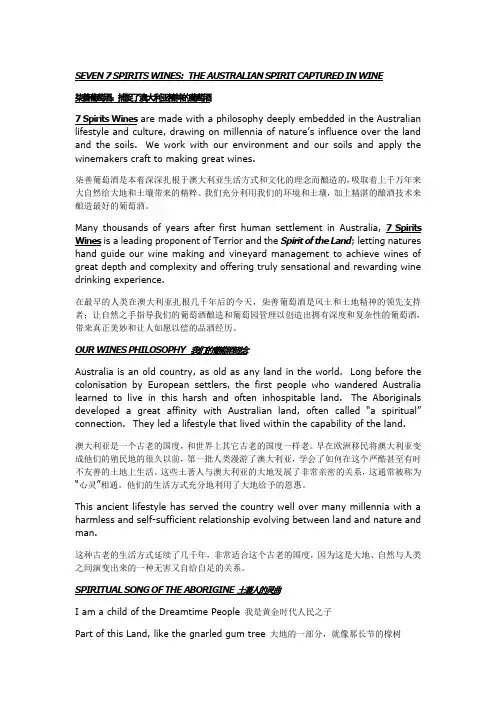
SEV EN 7 SP IR ITS W IN ES: TH E AU STRA LIAN SP IR IT CAP TUR ED IN W IN E柒善葡萄酒:捕捉了澳大利亚精神的葡萄酒7 Spi ri ts Wi nes are made with a philosophy deeply embedded in the Australian lifestyle and culture, drawing on millennia of nature’s influence over the land and the soils. We work with our environment and our soils and apply the winemakers craft to making great wines.柒善葡萄酒是本着深深扎根于澳大利亚生活方式和文化的理念而酿造的,吸取着上千万年来大自然给大地和土壤带来的精粹。
我们充分利用我们的环境和土壤,加上精湛的酿酒技术来酿造最好的葡萄酒。
Many thousands of years after first human settlement in Australia, 7 Spi ri ts Wi nes is a leading proponent of Terrior and the Spi ri t of the La nd; letting natures hand guide our wine making and vineyard management to achieve wines of great depth and complexity and offering truly sensational and rewarding wine drinking experience.在最早的人类在澳大利亚扎根几千年后的今天,柒善葡萄酒是风土和土地精神的领先支持者;让自然之手指导我们的葡萄酒酿造和葡萄园管理以创造出拥有深度和复杂性的葡萄酒,带来真正美妙和让人如愿以偿的品酒经历。
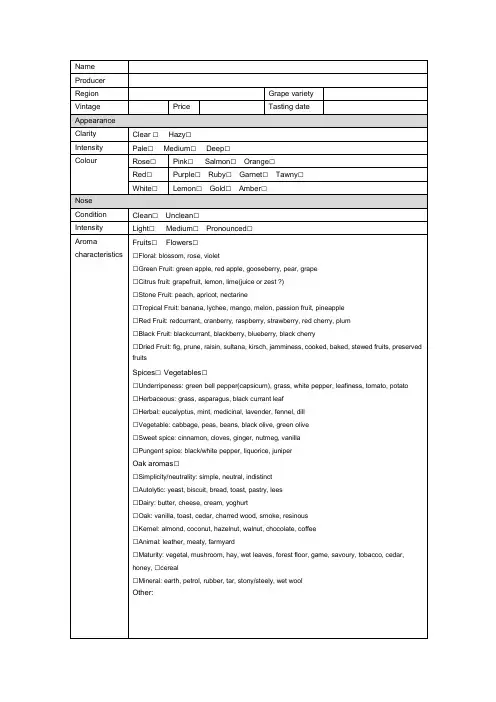
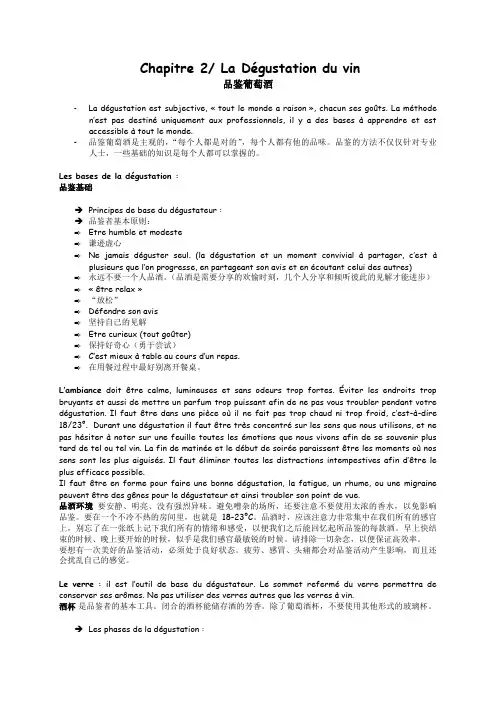
Chapitre 2/ La Dégustation du vin品鉴葡萄酒-La dégustation est subjective, « tout le monde a raison », chacun ses goûts. La méthode n’est pas destiné uniquement aux professionnels, il y a des bases à apprendre et est accessible à tout le monde.-品鉴葡萄酒是主观的,“每个人都是对的”,每个人都有他的品味。
品鉴的方法不仅仅针对专业人士,一些基础的知识是每个人都可以掌握的。
Les bases de la dégustation :品鉴基础→Principes de base du dégustateur :→品鉴者基本原则:⇨Etre humble et modeste⇨谦逊虚心⇨Ne jamais déguster seul. (la dégustation et un moment convivial à partager, c’est à plusieurs que l’on progresse, en partageant son avis et en écoutant celui des autres)⇨永远不要一个人品酒。
(品酒是需要分享的欢愉时刻,几个人分享和倾听彼此的见解才能进步)⇨« être relax »⇨“放松”⇨Défendre son avis⇨坚持自己的见解⇨Etre curieux (tout goûter)⇨保持好奇心(勇于尝试)⇨C’est mieux à table au cours d’un re pas.⇨在用餐过程中最好别离开餐桌。
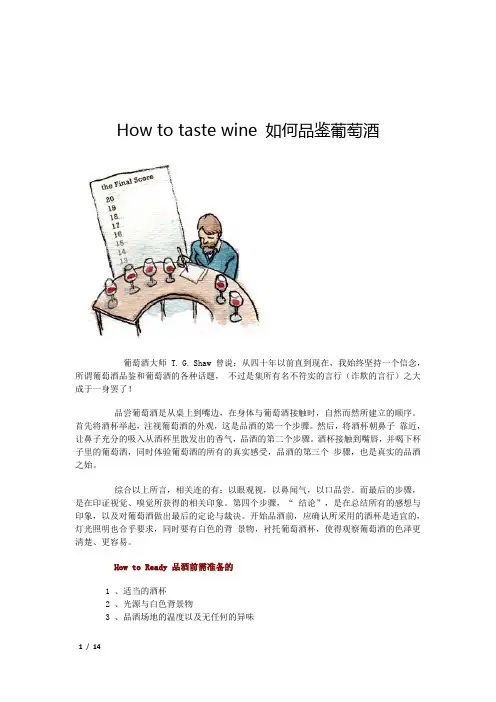
How to taste wine 如何品鉴葡萄酒葡萄酒大师 T. G. Shaw 曾说:从四十年以前直到现在,我始终坚持一个信念,所谓葡萄酒品鉴和葡萄酒的各种话题,不过是集所有名不符实的言行(诈欺的言行)之大成于一身罢了!品尝葡萄酒是从桌上到嘴边,在身体与葡萄酒接触时,自然而然所建立的顺序。
首先将酒杯举起,注视葡萄酒的外观,这是品酒的第一个步骤。
然后,将酒杯朝鼻子靠近,让鼻子充分的吸入从酒杯里散发出的香气,品酒的第二个步骤。
酒杯接触到嘴唇,并喝下杯子里的葡萄酒,同时体验葡萄酒的所有的真实感受,品酒的第三个步骤,也是真实的品酒之始。
综合以上所言,相关连的有:以眼观视,以鼻闻气,以口品尝。
而最后的步骤,是在印证视觉、嗅觉所获得的相关印象。
第四个步骤,“ 结论”,是在总结所有的感想与印象,以及对葡萄酒做出最后的定论与裁决。
开始品酒前,应确认所采用的酒杯是适宜的,灯光照明也合乎要求,同时要有白色的背景物,衬托葡萄酒杯,使得观察葡萄酒的色泽更清楚、更容易。
How to Ready 品酒前需准备的1 、适当的酒杯2 、光源与白色背景物3 、品酒场地的温度以及无任何的异味When to Taste 品酒的时机理想的品酒时间约于用餐之前,同时又可当作餐前的开胃酒。
早上的 11 时,或傍晚 6 时左右的时间,都颇符合这样的时段。
若您不想空腹之状态下品酒(空腹之状态下酒精很快地就会被吸收),这时可喝下一大杯的牛乳或水,以及一份淡味的三明治作为“ 添底物” 。
如果您的酒量甚差,建议您于品酒进行其间,可饮下大量的水分,这种方法相当的有效用。
ISO 葡萄酒品酒专用杯品酒所使用之酒杯被认定以 ISO(International Standard Organization)葡萄酒杯最为理想。
无色、水晶玻璃杯,含铅量比率约 9% 或更高。
品酒时,斟入酒杯内之容量约 35-50 毫升(C.C.)适当的酒杯 The Wine Glass适当的酒杯可使品酒时的准确性提高,无论是酒的外观之判断,以及气味的辨识,都比不适当的酒杯优越许多,因此,专家们都推崇以 ISO 葡萄酒杯,作为品鉴葡萄酒最佳的选项。
Acetic: Tasting term indicating an undesirable vinegary smell.醋酸的:一个用来表述不愉快酸味的品尝术语。
Acidic: Used to describe wines whose total acid is so high that they taste tart or sour and have a sharp edge on the palate.酸的:用于形容葡萄酒的总酸度过高以至于尝起来具有辛辣或酸腐味且在口腔中具有锋利的边角感。
Acids:Essential component of all wines. Several different acids are found in grapes and wine. Grapes are one of the few fruits to contain tartaric acid, the major wine acid and the most important source of acidity in wine. Smaller amounts of malic acid, citric acid and lactic acid can also be found, as can acetic acid. See also 'volatile acidity'.酸:所有酒中的基本成分。
在葡萄和葡萄酒中能找到几种不同的酸。
葡萄是少数含有酒石酸的水果的一种,(酒石酸是酒中主要的酸性物质,同时也是酒的酸度的最重要来源)。
除醋酸外,还有少量的苹果酸,柠檬酸和乳酸。
也可参考'volatile acidity挥发性酸'.Acrid: Describes a harsh or bitter taste or pungent smell that is due to excess sulfur.辛辣的:形容一个粗糙或苦的味道又或者是由于过量的硫磺而产生的刺激性气味。
How-to-taste-wine-如何品鉴葡萄酒How to taste wine 如何品鉴葡萄酒葡萄酒大师T. G. Shaw 曾说:从四十年以前直到现在,我始终坚持一个信念,所谓葡萄酒品鉴和葡萄酒的各种话题,不过是集所有名不符实的言行(诈欺的言行)之大成于一身罢了!品尝葡萄酒是从桌上到嘴边,在身体与葡萄酒接触时,自然而然所建立的顺序。
首先将酒杯举起,注视葡萄酒的外观,这是品酒的第一个步骤。
然后,将酒杯朝鼻子靠近,让鼻子充分的吸入从酒杯里散发出的香气,品酒的第二个步骤。
酒杯接触到嘴唇,并喝下杯子里的葡萄酒,同时体验葡萄酒的所有的真实感受,品酒的第三个步骤,也是真实的品酒之始。
综合以上所言,相关连的有:以眼观视,以鼻闻气,以口品尝。
而最后的步骤,是在印证视觉、嗅觉所获得的相关印象。
第四个步骤,“ 结论”,是在总结所有的感想与印象,以及对葡萄酒做出最后的定论与裁决。
开始品酒前,应确认所采用的酒杯是适宜的,灯光照明也合乎要求,同时要有白色的背景物,衬托葡萄酒杯,使得观察葡萄酒的色泽更清楚、更容易。
How to Ready 品酒前需准备的1 、适当的酒杯2 、光源与白色背景物3 、品酒场地的温度以及无任何的异味When to Taste 品酒的时机理想的品酒时间约于用餐之前,同时又可当作餐前的开胃酒。
早上的11 时,或傍晚 6 时左右的时间,都颇符合这样的时段。
若您不想空腹之状态下品酒(空腹之状态下酒精很快地就会被吸收),这时可喝下一大杯的牛乳或水,以及一份淡味的三明治作为“ 添底物” 。
如果您的酒量甚差,建议您于品酒进行其间,可饮下大量的水分,这种方法相当的有效用。
ISO 葡萄酒品酒专用杯品酒所使用之酒杯被认定以ISO (International Standard Organization)葡萄酒杯最为理想。
无色、水晶玻璃杯,含铅量比率约9% 或更高。
品酒时,斟入酒杯内之容量约35-50 毫升(C.C.)适当的酒杯The Wine Glass适当的酒杯可使品酒时的准确性提高,无论是酒的外观之判断,以及气味的辨识,都比不适当的酒杯优越许多,因此,专家们都推崇以ISO 葡萄酒杯,作为品鉴葡萄酒最佳的选项。
介绍西班牙红酒英语作文Spanish red wine is renowned worldwide for its rich history, distinctive flavors, and cultural significance. Originating from various regions across Spain, such as Rioja, Ribera del Duero, and Priorat, Spanish red wines offer a diverse range of styles and profiles to suit every palate.One of the most famous Spanish red wines is Rioja, hailing from the La Rioja region in northern Spain. Rioja wines are primarily made from the Tempranillo grape, known for its bold fruit flavors and smooth tannins. These wines often exhibit notes of cherry, plum, and vanilla, with a hint of spice from oak aging. Rioja wines are classified based on their aging process, with joven (young), crianza, reserva, and gran reserva categories offering varyinglevels of complexity and maturity.Another prominent Spanish red wine region is Ribera del Duero, located in the Castilla y León region. Wines fromRibera del Duero are predominantly crafted from the Tinto Fino grape, a local variant of Tempranillo. These wines are known for their intense dark fruit flavors, firm tannins, and robust structure. Ribera del Duero reds often display aromas of blackberry, plum, and licorice, with hints of tobacco and cedar from oak aging. The region's extreme continental climate, with hot summers and cold winters, contributes to the grapes' concentration and flavor development.In the Catalonia region, Priorat stands out as a producer of premium red wines. Priorat wines are typically made from a blend of indigenous grape varieties, including Garnacha (Grenache) and Cariñena (Carignan), grown on steep, rocky slopes known as "licorella." These mineral-rich soils impart a distinct terroir to Priorat wines, characterized by bold fruit flavors, firm tannins, and vibrant acidity. Priorat reds often exhibit notes of ripe black cherry, blackcurrant, and dried herbs, with a lingering, complex finish.Spanish red wines are not only esteemed for theirexceptional quality but also for their culturalsignificance and tradition. Wine has been an integral part of Spanish culture for centuries, with vine cultivation and winemaking techniques passed down through generations. Spanish red wines are often enjoyed alongside traditional Spanish cuisine, such as tapas, paella, and roasted meats, enhancing the dining experience with their complementary flavors and textures.Moreover, Spain's diverse geography, with its varying climates, altitudes, and soil types, contributes to the unique character of its red wines. From the lush greenhills of Galicia to the arid plains of Castilla-La Mancha, each wine-producing region in Spain offers its own distinctive terroir and winemaking style, resulting in a kaleidoscope of flavors and expressions.In recent years, Spanish red wines have gained increasing recognition and popularity on the global stage, attracting wine enthusiasts and connoisseurs alike. With their exceptional quality, diverse range of styles, andrich cultural heritage, Spanish red wines continue tocaptivate and delight wine lovers around the world. Whether enjoyed on their own or paired with food, Spanish red wines offer a truly unforgettable sensory experience that celebrates the essence of Spain's winemaking tradition.。